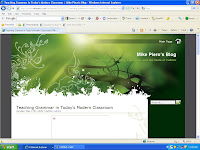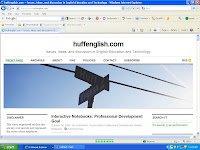Lesson Plan
PLANNING
(This would most likely be done in 8th or 9th grade English class; however, it could easily be adjusted for an older grade level as well)
Date: 12/1/09
Title/Subject of Lesson: Final Poetry Project
Objectives: Students will be able to utilize the tools of poetry they have learned to create their own poems. They will also be able to make poems using picture prompts.
State Core Curriculum Standard:
[1b] Enjoy the processes and outcomes of reading and writing
[3a] Understand that language enhances and identifies human beings as meaning makers
[2c] Extended Writing
Use narrative details (e.g., dialogue, descriptions, imagery, symbolism)
Materials Needed: Computers with both Microsoft Word and Internet access
PERFORMING
Continuation from Previous Lesson: They should have finished the homework assignment to review a few of the different tools we’ve discussed by reading the assigned poems (see document “ToolsofPoetryReview”).
Lesson Presentation:
A) Getting Started
· In computer lab, have each student open
www.piclits.com· Each of them will create an account
B) Directing the Learning
· Explain and demonstrate how to use the Drag-and-Drop feature
o Show personal examples from My Piclits
· Students will create and save their own Drag and Drop PicLits (2). They will choose their favorite one and copy the text to a Word document. Above the text, they will describe the picture they used.
· Explain and demonstrate the Freestyle feature (Show examples from My PicLits)
· Students will create and save their own Freestyle Poem (1).
· Student will then choose 2 different tools from the Review sheet (Rhyme, Sound, Alliteration, Line Breaks, Imagery) and write two new Freestyle Poems – each one focusing on one of the tools we discussed as a class. They will copy the text from these two poems to their Word document. Above the poem, they will simply describe the picture.
C) Bringing the Lesson to a Conclusion
· Students will print off the Word document where they have saved their PicLits projects.
Assignment: Students will find a picture (Can be a magazine picture, a home photo, an image from a book, etc.) and use it as a prompt to create a poem. They will bring the poem and the picture to class and share their poems in front of the class as part of the class Poetry Jam.
Here are my examples that will be shown as demonstrations
Drag-and-Drop:
 See the full PicLit at PicLits.com
See the full PicLit at PicLits.com See the full PicLit at PicLits.com
See the full PicLit at PicLits.comFreestyle:
 See the full PicLit at PicLits.com
See the full PicLit at PicLits.com See the full PicLit at PicLits.com
See the full PicLit at PicLits.com




















